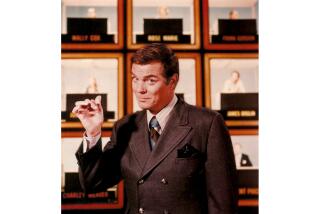Movie Is Chalking Up Renewed Interest in Pool
- Share via
Arnie Satin racked the balls on the pool table, took careful aim through his thick glasses, then broke the balls with a loud bang.
Satin, 59, is proprietor of New Hollywood Billiards, opened 70 years ago at 5504 Hollywood Blvd. Not only is it the oldest billiards room in Los Angeles, it may be the most incessant: A sign at the red canopied entrance to the 22-table basement pool parlor proclaims: “Open 10 a.m. to God Knows When.”
“We stay open around-the-clock if we have players. We never close weekends from Friday morning at 10 to 2 a.m. Monday and stay open beyond that if anyone’s still here,” said Satin who ran seven pool halls in Brooklyn before buying New Hollywood Billiards 14 years ago.
Above each table, green felt glowing in the blaze of overhead lights, was the name of an all-time great like Willie Hoppe, Willie Mosconi, Raymond Ceulemans, Harold Lindrum, George Chanier, Alfredo DeOro, Harold Worst.
The short, bearded former pool hustler was asked if the new movie “The Color of Money” starring Paul Newman and Tom Cruise was having an impact on his business.
“Hey, let me tell you about pool,” Satin said as he hit one ball after another into the pockets. “In the 1920s there were 40,000 billiard rooms in the United States. Every town of any size had at least one.
“A room called Detroit Recreation in the Motor City had 250 tables. Imagine a pool hall with 250 tables and guys standing in line to play. New York had five places with more than 100 tables. Those were the days. . . .”
Renewed Interest
By 1960, he said, the game was in one of the worst slumps of all times, down to 4,000 pool rooms. Then along came the movie “The Hustler” starring Newman, Jackie Gleason and George C. Scott.
A combination of major-film exposure and manufacturers capitalizing on the renewed interest proved to be a bonanza. By 1965, noted Satin--who has produced world championship tournaments and is a recognized historian of the game--the number of pool rooms shot up to 19,000.
By the mid-1970s another slump set in and the number of pool halls dropped to about 12,000, where it remains today.
“Now we have this new hit movie (Martin Scorsese’s “The Color of Money,” a sequel to “The Hustler”). Everybody’s keeping their fingers crossed hoping it will do miracles. Our business is up about 18% the last six weeks because of the movie. The lasting effect is still anybody’s guess.”
At a table nearby were actors Allen Williams, 38, and John Pleshett, 44, regulars at Satin’s, playing “the gentleman’s game”--three-ball carom billiards.
“ ‘The Hustler’ turned me on to billiards 25 years ago,” Pleshett said. “ ‘The Color of Money’ can’t help but generate a lot of interest in the game,” Williams added.
Lee Boyar, 52, former top female pool player and now a receptionist and sales director for custom table makers American Billiard Manufacturing Co. in Long Beach, remembers the effect “The Hustler” had on the billiards industry 25 years ago:
“ ‘The Hustler’ generated so much interest in the game that the streets of Chicago and other cities were filled with people toting cue cases. Business has picked up noticeably since ‘The Color of Money’ was released,” she said. “Maybe lightning will strike twice.”
Terry Moldenhauer, 42, owner of Triple A Billiards in North Hollywood, a custom table manufacturer and retail store, recalled the boom in family pool rooms in the late 1960s and early 1970s:
“By the late 1970s and early 1980s many of the family pool halls had folded. The economics of running a place did them in--rent too high, not enough revenue. That coupled with the advent of video games killed most family pool halls.”
Moldenhauer, who’s vice president of the 18-member Southern California Billiard Dealers Assn., said discussion about “The Color of Money” dominated the organization’s monthly meeting last week.
“All agreed the movie is a shot in the arm. Sales of cue sticks are up 25%. Pool table sales have increased. Throughout history the billiards industry, like a roller coaster, has had its ups and downs. Hopefully we’re on an upswing. . . .
“One major problem with the game is that it has lacked younger players for a long time. Most of the top players are older. We’re seeing an impact from ‘The Color of Money’ because kids need an idol to identify with and relate to. Tom Cruise could well be that person and generate tremendous interest in the game with young people.”
He talked of hustlers. “They’re still around. Guys are still making a living hustling games in pool rooms. They’re not hitting the road and traveling from one part of the country to another as shown in ‘The Color of Money.’ Traveling costs too much.
“Instead they float from one room to another looking for action. Wherever they can hustle a buck. It’s a tough way to make a living. Fat one day with all kinds of money, the next day broke.”
Lou Butera, 49, was world pool champion in 1973. But he got his name, “The Machine Gun,” because he is considered the world’s fastest pool player. Butera, a native of Pittston, Pa., a coal mining town, runs a family pool hall in Simi Valley, Lou Butera’s Billiards.
Pool has been Butera’s bread and butter all of his life. “I’ve been playing the game since I was 8,” recalled “The Machine Gun.” “Let’s put it like this. My family never went hungry and I got a wife and seven kids. Pool has been good to me.
“I don’t hustle games. I’m a gambler. I walk into a place and announce that I’m a hell of a player who’s looking for action. Ego takes over. I never lack for a game.”
Nicknames go along with pool. Some of the better-known players are identified by their pool room sobriquets. Players like the Velvet Foghorn, Boston Shorty, Weenie Beanie (he owned a string of hot dog stands), Cornbread Red, Cryin’ Sam and of course Minnesota Fats, who would strut into a pool room and chant: “I’ll play any man. From any land. Any game he can name. For any amount he can count.”
Pool is enjoyed by the extremely wealthy and those at the bottom of the economic heap. Shakespeare wrote about the game in “Antony and Cleopatra”: “Let us to billiards. . . .” Mary, Queen of Scots’ bitterest complaint about being held prisoner by Queen Elizabeth I in the 16th Century was that her billiards table had been taken from her.
“It’s a one-on-one game,” allows Austin “Last Pocket” Stirratt, 65, a long-time pool hall habitue. “I never play for more than five dollars a game,” he insists. “It’s a game that takes a lot of practice, a lot of skill. You got to know the kinetics of it.
“A player can psyche out a player. Even if he loses he psyches out himself, convincing himself it was just an accident, that he will win the next one.”
Seymour Sterling, 63, a 350-pound, six-foot pool player and partner in New Hollywood Billiards with Arnie Satin and George Arnoek, 59, talked about a 95-year-old pool player he knows.
“He’s in terrific shape. His doctor swears he owes his splendid health and longevity to his daily pool games, walking about a mile around the table, bending over, stretching his muscles.”
The Hollywood neighborhood where the 70-year-old basement pool hall is located has deteriorated in recent years. The sidewalks are jammed with heavy drug users.
“We’re an oasis,” said Satin. “We have our own parking lot. We have iron gates leading to the tables, opened when paying customers come and go. Junkies come down and want to use the bathroom and shoot up. No one uses our bathrooms except the customers. This is a safe, secure place, frequented by high-class people. We haven’t had a fistfight in the 14 years I’ve been here. We don’t allow it.”
Satin said he could write a history of civilization from the perspective of the pool rooms in which he has thrived the past 49 years.
“Just imagine the drama day after day in these 10,000 square feet of grandeur,” he mused.
More to Read
Inside the business of entertainment
The Wide Shot brings you news, analysis and insights on everything from streaming wars to production — and what it all means for the future.
You may occasionally receive promotional content from the Los Angeles Times.










